Onam: A Major Festival of Kerala
Onam festival is the most prominent festival celebrated in the state of Kerala in South India. It was mentioned in the Hindu calendar that it is believed that Onam festival is celebrated in the month of Chingam. This festival is celebrated with full enthusiasm in Kerala. It is one of the most prominent festivals of the state of Kerala held to commemorate the harvesting of crops.
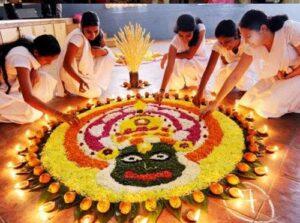
If you want to see a glimpse of the culture of Kerala, then see this Onam festival. Kerala’s culture is considered a symbol of traditional values and joy. People of Kerala celebrate this Onam festival for 10 days. It originates in the Atham nakshatra. The Malayalam New Year, which the whole community celebrates together, falls on the same day as the festival.
Mythological Significance of Onam festival
The operation of celebrating this festival dates back to the time of King Mahabali. King Mahabali, despite being the king of the Asuras, was famous for his love of people and justice system. Every individual in his realm was content and benefited from wealth. According to legend, the gods were envious of King Mahabali’s increased wealth and power. He called upon Lord Vishnu to help.
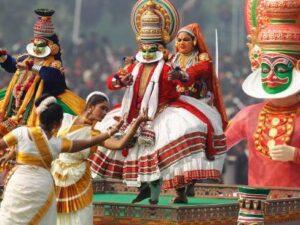
Vishnu took on the Vamana avatar and requested three steps of land from King Mahabali. King Mahabali was kind enough to grant him permission. In his first two steps, Vamana measured the entire sky and the earth. When Vamana Avatar asked him that I have measured the earth and the sky in two sides, then where should I keep the third step.
King Mahabali bowed his head in front of Vamana. So, Lord Vishnu sent him to Hades. Lord Vishnu blessed him and said that he could come to meet his people once a year. When King Mahabali comes to meet his subjects, Onam festival is celebrated on that day. This festival is also celebrated as a festival of happiness and prosperity.
Onam festival is celebrated for 10 days
Onam festival is celebrated for 10 days, and every day has a different name. Atham, Chothi, Optradam, Thiruvonam, Purdam, Anizm, Thrikketta, and Visakam. Every day has a unique meaning, and there are numerous religious and cultural celebrations. On these days, people prepare traditional dishes, attend social gatherings, decorate their homes, and create “pookkalam” out of colourful flower petals.
1.Onam, or Atham, is the first day. The tradition of creating floral rangoli, or “Pookkalam,” in the courtyards of the homes began on this day.
2.Chithira: This day is significant because Pook kalam is decorated with more ornate and vibrant decorations.
3.Vishwakarma: Traditional dance and music events are held on this day.
4.Anizam: On this day, customary contests and games get underway.
5.Thrikketta: People visit temples to worship on this day.
6.Moolam: People dance traditional dances like “Thiruvathira” and “Kathakali” on this day.
7.Purdam: This day is particularly observed for social service and religious ceremonies.
8.Optradam: People finish decorating their homes on this day, which also serves as the last day of festival preparations.
9.Thiruvonam: The day that matters most
Major Onam festival
There are cultural and religious events on this day which are as follows:
To celebrate Pulkam in the festival, it is decorated with colorful flowers. It takes ten days to form specifically from Atham to Thiruvonam, and every day it gets bigger and more beautiful. Traditionally, it has been used to greet guests, particularly King Mahabali’s arrival.
A unique vegetarian dish called Onsadya is served on a banana leaf. More than 26 dishes are included in it, including pickles, chips, payasam, olan, thoran, avial, and sambar. All of the family members gather together and share food on Onsadya, signifying love and harmony.
Kathakali: The traditional dance of Kerala, known as “Kathakali,” is performed during Onam. This type of dance is based on myths such as the Ramayana and the Mahabharata, which combine lavish costumes, acting, and music.
The Snake Boat Race, also known as Vallam Kali, is a significant Onam celebration in Kerala. Several sailors compete in it while seated on a massive snake-boat. It is a part of Kerala’s rich cultural legacy in addition to being a representation of physical strength.
Thiruvathira: Women perform this traditional dance, especially on the occasion of Onam. This is a group dance that features women dancing in circles. Its primary goal is to wish harmony and prosperity to the family.
Cultural and Social Aspects of Onam
The Onam festival showcases Kerala’s rich culture, traditions, and social cohesion in addition to its religious significance. People from all castes, classes, and religions come together to celebrate this festival in unity. This festival, where everyone forgets their differences and celebrates together, is a symbol of prosperity, happiness, and social harmony.
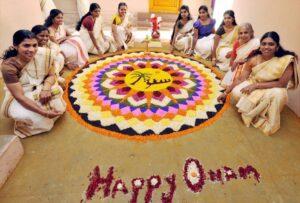
Onam is marked by customs that include house decorating, donning new clothes, and attending social gatherings. Furthermore, because it is observed during harvest season, this festival highlights the value of agriculture. On this day, farmers give thanks to God and hope for a bountiful crop.
Onam festival and modernity
The characteristics of Onam festival have also evolved in the modern era. Today, both modern and traditional customs are used to celebrate this festival. Cities organize numerous cultural events to go along with the extravagant celebrations of this Onam festival. Nowadays, Onam is widely celebrated outside of Kerala by Malayalees who have moved to other states and countries, and they do it with great fanfare.
The festival of Onam remains a special significance for tourists. During this festival, people from many states of India arrive in the state of Kerala.
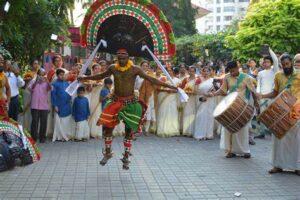
People enjoy the cultural heritage and heritage of Kerala to the fullest and also enjoy a variety of delicacies during the festival. The state government also organises this festival on its behalf. Which not only promotes tourism but also shows the specialty of this festival. Kerala has a robust economy as well.
Social and Economic Significance of Onam festival
Onam festival is religious as well as has its social and economic significance. Local retailers, artisans, and other businesspeople schedule special sales events during this time. In Kerala, a lot of people purchase new clothing, jewellery, and other household items during Onam, which boosts market activity.
In addition, a number of other industries are supported, including tourism, handicrafts, and agriculture. Particularly traditional and handicraft artisans exhibit their work and make sales during the Onam festival. Kerala’s traditional crafts and arts are also promoted during this time, which helps the state’s economy and safeguards the state’s cultural legacy.
Conclusion
One such Keralan festival, Onam, has profound social, cultural, and economic significance in addition to its religious significance. This celebration represents cultural legacy, social harmony, and the beauty of the natural world. The numerous festivities and events held during Onam have grown to become the main draw both domestically and abroad.
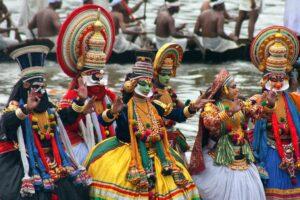
The Onam festival tells us that we can overcome any obstacle in life if we work together, are committed, and have love. The story of King Mahabali and his devotion to his subjects serve as a reminder that genuine happiness and prosperity come from friendly cooperation. Let us remember, as we celebrate this festival, that our customs and rituals help to keep us socially cohesive and connected to our history.
